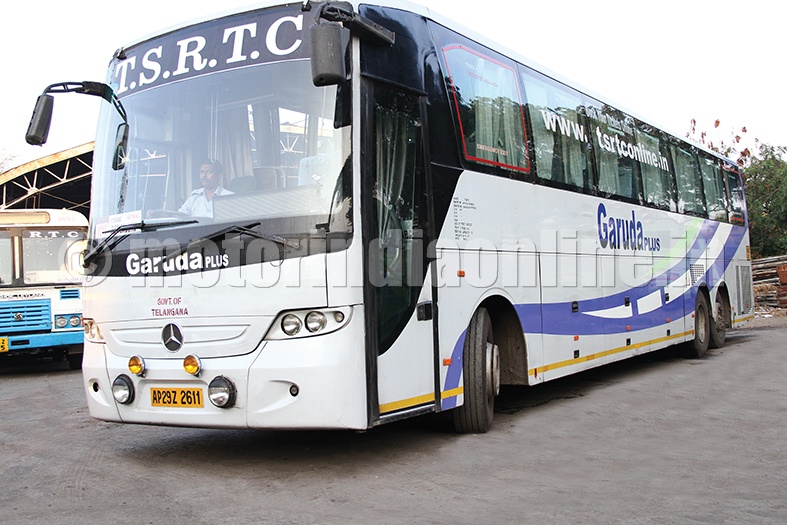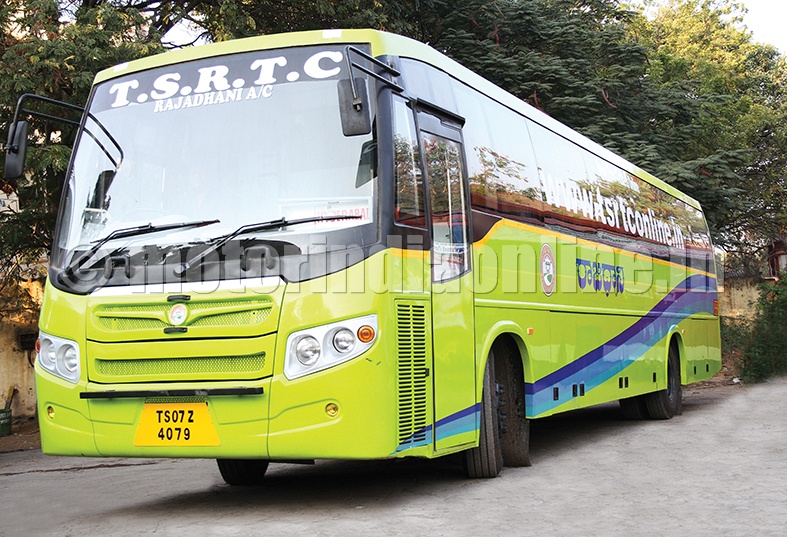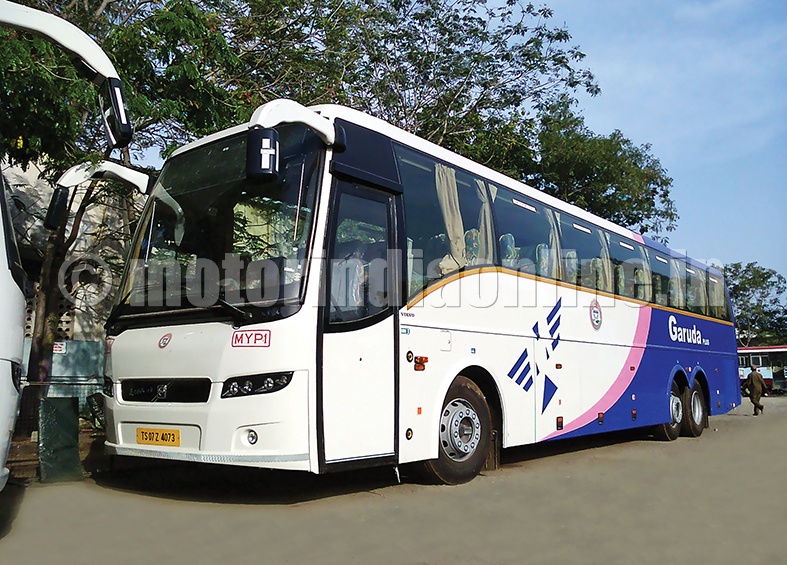The erstwhile Andhra Pradesh State Road Transport Corporation (APSRTC) had one of the largest fleets in the country, with a Guinness World Record to its credit of a fleet of 22,000 buses as early as in 1999. However, post the formation of Telangana, the Corporation was split into two, and the newly-started entity is known as the Telangana State Road Transport Corporation (TSRTC).
TSRTC, which continues to carry forward APSRTC’s legacy of being one of the leading STCs in India, has interesting plans to carve a niche for itself in the industry. We met Mr. G.V. Ramana Rao, Jt. Managing Director, TSRTC, at his Bus Bhavan office in Hyderabad for a detailed interaction on how the newly-incubated, yet large-size STC plans to move forward.
Excerpts:
TSRTC is one of the newest STCs in the country. When was the Corporation officially formed and what is your fleet size at present?
We are operational since June 3, 2015. We have a fleet of 10,500 vehicles, including 1,500 hired buses. We have about 123 AC buses used for inter-city applications such as Garuda, Garuda Plus and Indra, about 2,550 non-AC inter-city buses which run as Super Luxury and Deluxe and 3,800 rural buses. We have our major operations in Hyderabad with nearly 3,800 buses running in the city, of which 159 are AC low-floor ones like the Metro Deluxe and the rest non-AC.
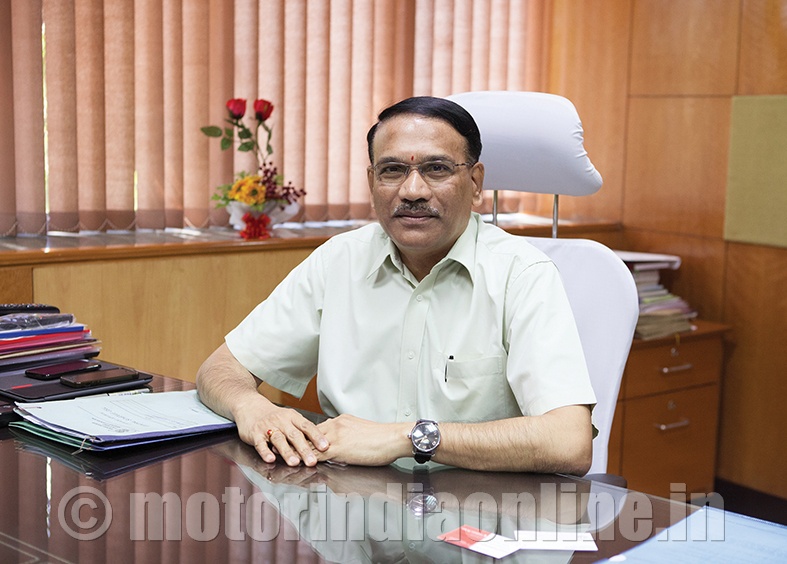
The average age of our fleet in terms of distance covered is around 4,00,000 km and we scrap the vehicles after 12,00,000 km. We cover about 34 lakh km with average daily revenue of nearly Rs. 9 crores day and transport around 92 lakh passengers every day, of which 35 lakhs are in Hyderabad. We have an inter-State agreement with Tamil Nadu, Chattisgarh, Karnataka and Maharashtra and operate buses to these States as well.
Being a relatively new STU, how are your financials at present and how do you plan to improve profitability?
Our overall revenue is close to Rs. 4,500 crores and we get Rs. 80-90 crores as additional revenue. We will continue to improve our revenues and reduce expenditure to move into profit zone soon. Employee salary at 52 per cent is our biggest expense, followed by fuel at 26 per cent, which is a result of the reduced high-speed diesel (HSD) price. We are trying to cut expenses by taking to the driver-cum-conductor approach wherever possible and thereby having conductors only for longer routes. The bus staff ratio is currently at 5.95 as against the earlier 8. We are consciously not filling the retirement positions and are outsourcing painting and some technical works. In fact, the cost of bus body building in-house was higher than when it was done outside, so we are cutting down manpower to the extent possible. We are also reducing fuel expenses by moving towards bio-diesel.
How strong is your service and maintenance capability and how is your preparedness for the bus body code?
We have two zonal workshops, at Hyderabad and Karimnagar, where we do complete vehicle overhaul, body repairs and bus-body building. We have bus body facilities at Hyderabad and Miyapur and are in the process of implementing the bus body code practices. The code calls for a lot of changes in bus body construction, and we shall comply with the norms set.
What are your plans for running buses on alternative fuels?
Currently we run about 130 buses using CNG. The initial recommended was for around 300 buses, but due to shortage of fuel, we are running only 130 vehicles at present. We are confident of getting more fuel from the Bhagyanagar Gas Project and are planning to further expand our CNG fleet.
In addition, we are also exploring the option of bio-diesel buses. We are running one depot with bio-diesel with 80:20 blend and are fairly happy with the operation in terms of fuel performance and emissions. We now propose to extend the bio-diesel usage to 35 depots with the 90:10 ratio and gradually hope to have all the 95 depots running a bio-diesel fleet. We have got the infrastructure and vendor base ready, so the complete conversion would happen in the next three months’ timeframe.
We are able to see a difference in the operating cost as the cost per km while using bio-diesel is Rs. 3 cheaper than HSD. So it gives us a lot of savings, apart from reducing the emission level. We are also working on diesel-hybrid buses and will be starting trial runs once we receive the kits for retro fitment.
Do you undertake any initiatives to stay connected to your passengers?
Connecting with passengers is one of the most important aspects of our operation. We have a commuters meet every month at all depots, with each depot having two to three mandals (taluks) which we intend to cover in two months’ time. This we do on a continuous basis and get feedback first hand from commuters. We also have another program called ‘Dial your DM’ (Deputy Manager) and ‘Dial your RM’ (Regional Manager) conducted every month across the State. This is a continuous process through which we receive a lot of feedback from passengers regarding new route requirements, cleanliness of buses and discrepancies, if any. We ensure the issues are addressed quickly and also keep them informed about the action taken.
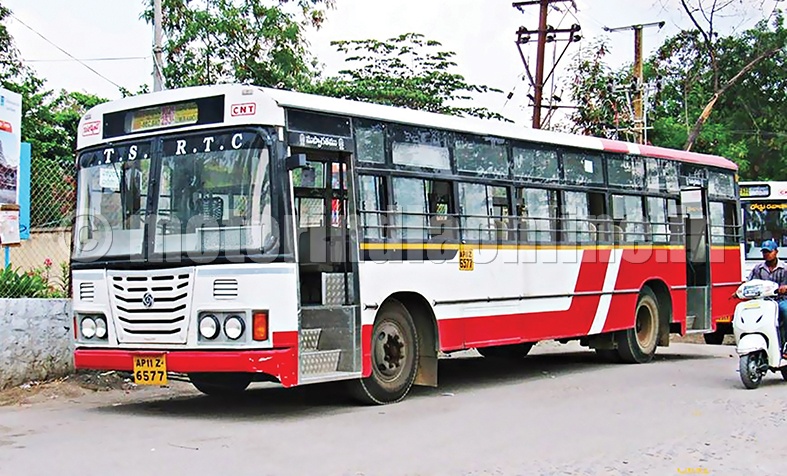
Do you plan to introduce smart card system and Intelligent Transport System (ITS)?
We are actually very serious in this regard, not just in cities but in districts as well. Under JnNurm we inducted about 1,600 buses with ITS with vehicle tracking system and GPS. We have a data centre to track and monitor the same and are planning to extend GPS tracking to remaining buses and complete the LED display board fitments in all bus shelters. All these would be integrated in the next 4 to 6 months with an App which will provide details of bus arrival, location, etc. The bus shelters in Hyderabad are maintained by the Greater Hyderabad Municipal Corporation with which we work in tandem. Additionally, we have 80 Metro Luxury buses fitted with security cameras.
Which are the bus brands in your fleet and are you happy with the performance of the vehicles?
Most of our buses are of Ashok Leyland brand and we are quite happy with their services. Six months back, we had inducted 24 Eicher vehicles and are happy with them too. They have improved on their products and are providing good parts and service support. We have recently inducted 20 Volvo multi-axle buses and have added them to our existing Garuda Plus fleet. After ABS was made mandatory, we have added 153 buses to our fleet, all with ABS.
How many buses were added to your fleet under the JnNurm II scheme?
Under the 2009 JnNurm scheme, we had engine and other technical problems with some of the vehicles, but somehow managed to get them solved. Through the JnNurm II scheme, we bought around 80 AC metro luxury buses sanctioned for Hyderabad, and all of them have been inducted. A total of 70 buses have been allotted for Karimnagar and 30 each for Kammam and Mahabubnagar, all 900 mm floor buses which would be inducted soon.
What are the last-mile connectivity options you provide and how do your buses complement the Metro rail service?
We are covering around 70 km in radius outside Hyderabad city and we connect them with city centre. We have basically two other modes of public transport – one is metro and the other is MMTS. We are providing feeder services to 16 MMTS stations and would also provide feeder services for the Metro stations when they commence operation. We would also realign our operations to match the corridor on which the Metro would be running.
Do you have any plan for AC bus fleet expansion? What are your views on the future of sleeper buses and how do you compete with the private sector?
We currently have around 120 AC buses and are sure to increase the number. Many APSRTC buses continue to come to Telangana and once we enter into an interstate agreement with APSRTC, we would definitely increase our AC bus fleet.
We cannot really compare our operations with the private sector as their overheads are much lesser and their ticketing policy is also different. But we have a good occupancy rate of about 70 per cent and are also coming up with flexible ticket pricing with a reduced fare on week days.
As far as sleepers are concerned, we currently have only three Venela sleeper buses operating to Bangalore. An important point here is that, barring inter-State routes, most of our destinations are within three to four hours of reach, which is why we have not gone for sleepers. Once we expand into more inter-State routes, we will go for more sleeper buses.
